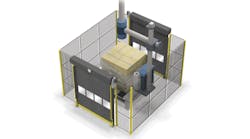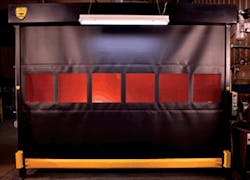In recent years, safety has taken on a new level of importance as more plants and distribution centers have automated and, in many cases, added robotics. Because of this, EN ISO, RIA (Robotics Industry Association) and other regulatory bodies have overhauled and revised their guidelines and requirements. While those regulatory changes have resulted in improved safety and other benefits, they have made what was already an often misunderstood subject even more complicated. Adding to the confusion is the fact that not all aspects or components of the automated or robotic systems are covered by the same codes or regulations as the robot portion alone – such as end-of-line stretch-wrapping operations. A brief overview of the new industrial safety regulations and best practices is in order.
Robotics at the Dock
Simple stretch wrap machines are nearly as ubiquitous at loading dock areas as dock levelers, seals or shelters. As with most all other industrial processes, what began as a manual operation (the arduous task of bending, pulling and moving shrink wrap around a pallet) is now commonly automated. Most dock employees are happy about this. However, this particular aspect of plant operation has long been overlooked as a hazard—and its dangers are increasing. As more facilities automate palletizing and stretch-wrapping, it becomes increasingly important to protect employees and pedestrians from coming into contact with the moving parts of those machines. With these suppliers adding other automated functions to their floors (such as intelligent conveyors, AGVs and AS/RS systems), it's critical that the safety methodology is similar to that of other robotic cells and is compliant with current standards.
There are no OSHA guidelines specific to the simple basic stretch wrap machines currently being used, other than the OSHA B1910 standards. As a rule of thumb, companies want to ensure safety of their employees and OSHA's General Duty Clause stipulates the following:
(a) Each employer:
(1) Shall furnish to each of his employees a place of employment which is free from recognized hazards that are causing or are likely to cause death or serious physical harm to his employees; and…
(2) Shall comply with occupational safety and health standards promulgated under this Act.
(b) Each employee shall comply with occupational safety and health standards and all rules, regulations and orders issued pursuant to this Act, which are applicable to his own actions and conduct.
Further, to make certain stretch-wrapping equipment is safe, it really should be guarded or contained per 29 CFR 1910.212(a)(3)(ii), General Requirements of All Machines. That rule states, "The point of operation of machines, whose operation exposes an employee to injury, shall be guarded. The guarding device shall be in conformity with any appropriate standards therefore, or, in the absence of applicable specific standards, shall be so designed and constructed as to prevent the operator from having any part of his body in the danger zone during the operating cycle."
Many times these safeguards are either grossly inadequate or completely ignored, removed and not even considered.
Robotics in Stretch Wrap Processes
Stretch-wrapping operations in warehouses and manufacturing facilities tend to be standalone processes and the trend toward automation of them is well established. More and more suppliers (OEMs) are incorporating robots into the wrapping process, allowing the robots to do the heavy work of handling the items to be palletized.
Additionally, intelligent conveyors, AGVs and in some cases, AS/RS systems, are responsible for the movement of the pallets to and from the pallet-wrapping machines. These process suppliers (integrators and OEMs) must ensure that the palletizers can communicate with AGVs and conveyor systems and the robotic processes being performed, tying the control systems and safety requirements into the process.
Clearly, safety methodologies similar to those used with other robotic applications need to be devised and implemented at this point. This safety methodology needs to be compliant with the latest standards, referencing the new RIA and EN ISO standards, while adopting a more sophisticated approach employing those technologies. From the standpoint of the operation, the approach should not deter efficiency.
2012: A Sea Change in Safety
Some of the biggest regulatory paradigm shifts in recent memory happened in the past two years, starting with the move from EN 954-1 to ISO 13849-1 and EN 62061 in 2012. When broken down to the basics, ISO 13849-1 provides a clearly defined set of rules to follow when an operation designs the safety system as applied to industrial machine control systems. Officially defined as "safety of machinery, safety-related parts of control systems, general principles for design," this regulatory shift was made necessary by increasingly complex manufacturing processes utilizing robotic and automated technology forcing safety control systems and methodology to keep pace.
The ISO 13849-1 standard is more quantitative than EN 954-1. It applies common sense and forces facility managers to validate their safety systems, whereas EN 954-1 was conceptual and only required facilities to apply safety devices (controls) properly, specifying non-programmable, out-of-date technology. Today's increasingly complex manufacturing processes require more complex systems to monitor their operation and keep machine operators safe. Automated processes, robotics and even time-tested processes all require considerable attention to ensure those processes can proceed both efficiently and safely. EN ISO 13849-1 will ultimately make for a much safer manufacturing environment because it accounts for the regulatory gaps that were starting to show in the older standards.
Harmonizing International and U.S. Standards
Adopted in May 2013, the RIA 15.06-2013 standard references ISO 10218-1 & 2, which addresses robots, robot systems and integration. It was written to be compliant with international standards already in place in Europe, making life easier for manufacturers and end users. This new standard will require better hazard identification, accounting for not only robot motion, but the task being performed. Additionally, it will require validation and verification of the safety systems employed and require designs that incorporate protective measures for the robot cell and the operator.
Some of the biggest changes we will see from the new RIA 15.06 industrial robot standard have to do with safety-rated motion and allowing for an operation to utilize advanced programmable safety devices. What this means is software will now be allowed "safety-rated" control of various aspects of the robot's function, limiting the area in which the robot operates and the speed of robot motion. This is a departure from older standards in that programmable safety controls were not allowed.
Thanks to technological advances in safety controls, these long over-due applications can now safely be implemented. In the past, engineers designing these systems guarded for the maximum space, speed and load of the robot. With these changes, the physical footprint of new robot cells should shrink. Coupled with the proper point-of-interaction safety devices, significant floor space savings could be realized.
Point-of-Interaction Safety Options
Presence-sensing devices such as light curtains and laser scanners are potential solutions for point-of-interaction safety. Automated barrier doors provide another option. They have many of the same benefits as presence sensors, plus several additional advantages. Most notably, automated barrier doors provide a physical barrier that can protect an employee and contain the process while at the same time restricting access to dangerous machine movement. This is particularly important for processes such as stretch wrapping in which inertia keeps machinery in motion even after it has shut down. Additionally, automated barrier doors can be located closer to the process, allowing for a much smaller footprint in the facility.
The most advanced roll-up automated barrier doors offer high-speed, high-cycle technology, as well as PLe hold-down mechanisms and safety rated non-contact interlock switches and controls. Most automated doors function from the top down, but some have been designed to operate from the ground up. This allows machine operators to easily interact with the process utilizing overhead cranes to load and unload large, heavy parts. They are also a great option for interaction points that have a very limited space.
The Broader Context
As new regulations like RIA 15.06 and EN ISO 13849-1 are adopted, it is important that facility managers keep up on the latest safety technologies available to match the right product to the right process, taking not only potential machine hazards into consideration, but the task being performed. It is also important that they look past the lack of specific stretch wrap safety regulations when making equipment decisions. Instead, we should consider the broader context of OSHA language, and guard "the point of operation of machines, whose operation exposes an employee to injury." Clearly, automated and/or robotic stretch wrap operations fall into this category. Given the recent advances in their design and technology, automated barrier doors can be an excellent option to guard these machines and protect operators, ultimately increasing productivity and the level of safety for years to come.
Eric Esson is national sales and marketing manager for Frommelt Safety Products (www.frommeltsafety.com).




